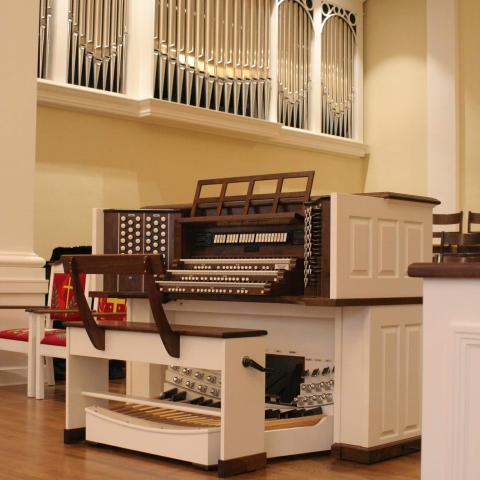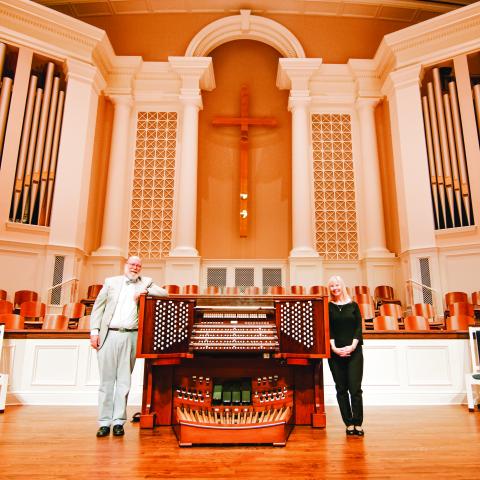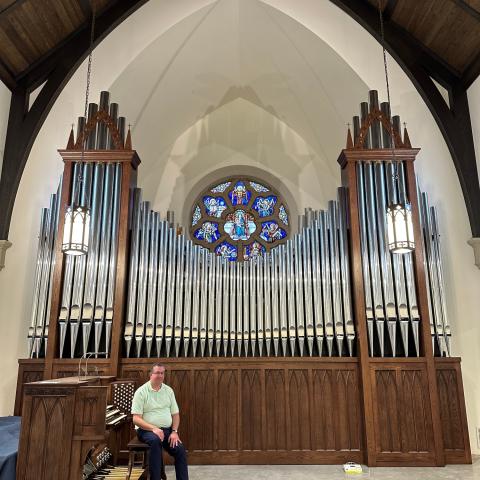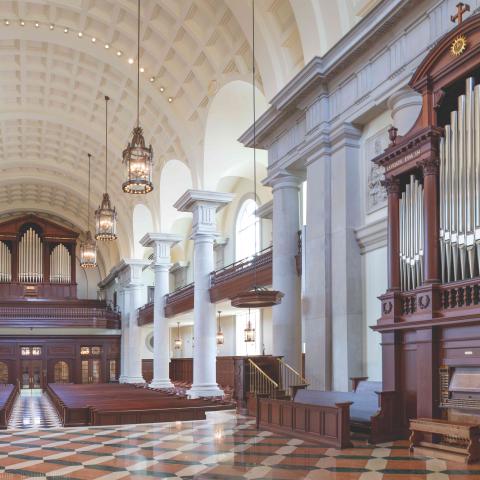Dobson Pipe Organ Builders, Ltd., Lake City, Iowa
Bruton Parish Church, Williamsburg, Virginia

Bruton Parish Church is immediately recognizable as an important and large edifice among eighty-eight original and intact eighteenth-century structures in Colonial Williamsburg where hundreds of other early houses, shops, and public buildings have been reconstructed. Founded in 1674, the name of the parish comes from the town of Bruton, in the English county of Somerset, which was the ancestral home of several leading Colonial figures. Construction of the present building began in 1712 to a design of Governor Alexander Spotswood and was completed three years later. It was enlarged in 1752 when the Vestry voted to make the east end as long as the west, extending the chancel by twenty-five feet. The tower was added in 1769. It was Bruton’s rector, the Reverend William A. R. Goodwin, D.D., who first conceived the restoration of Williamsburg to its colonial state. Goodwin removed Victorian changes to the church early in the twentieth century, and his work was later taken up by the Colonial Williamsburg Foundation in its restoration of the building between 1938 and 1941. It was designated a National Historic Landmark in 1970.
Bruton has a lengthy organ history. In 1729, Governor William Gooch wrote to an unidentified English Lord:
I am prevailed upon by Gentlemen of the Country to Beg the favor of your Lordship to intercede with His Majesty for an organ for our church at Williamsburg . . . . As such gifts my Lord have sometimes been made by royal Bounty to other places in America; the subjects here most humbly presume to hope, that they may have as just a claim . . . as any people in any part of his Majesty’s Dominions.
The parish’s unrequited interest found expression in the 1741 Journals of the Virginia Legislature, where it was asked: “whether an organ, to be bought by the Public, and appropriated to the Use of Divine Service, at the Church where the Seat of Government shall be, will not add greatly to the Harmony of Praise to the Supreme Being?” Further disappointment followed until finally, in 1752, the Assembly passed an act authorizing “the purchase of a musical organ, for the use of, and to be placed and kept in the said church.” Still, three years elapsed before an organ was ordered from London, its maker unknown to us today.
The new organ was played by Peter Pelham, who was born in England but raised in Boston, where he studied with Charles Theodore Pachelbel and eventually served as organist of Trinity Church following a sojourn of several years in Charleston, South Carolina. He moved to Williamsburg around 1750, where he not only became Bruton’s organist but also ran a music store, gave keyboard lessons, supervised the printing of currency, and was appointed keeper of the Public Gaol. He conveniently merged this last activity with his playing, frequently pressing a prisoner into service to pump the organ.
The instrument Pelham knew was replaced in 1835 with an organ by Henry Erben, about which little is known apart from its installation in a newly built gallery in the church’s east end, now the liturgical west after a re-ordering of the space earlier in the decade. In 1856, Erben’s organ was in turn replaced by Pomplitz & Rodewald of Baltimore.
At the dawn of the twentieth century, the Hutchings-Votey Organ Co. provided a new instrument, installed in the chancel, which by this time had been returned ad orientem. Some of its pipes were retained in Opus 968 of the Aeolian-Skinner Organ Co. That instrument, rebuilt on six occasions since its construction in 1937 and growing from 12 ranks to 105, was crowded into the attic, into the east galleries (including inside a 1785 organ case by Samuel Green set up there in 1939), and within the church tower. Faced with increasing mechanical unreliability and advised by consultants that a new, smaller organ more advantageously sited would yield both musical and maintenance benefits, the parish undertook a search for an organbuilder. That process came to its conclusion in February 2016 with the signing of a contract between Bruton Parish Church and Dobson.
This organ, the ninety-sixth new instrument our workshop has created, stands in the east gallery, in the space formerly occupied by the Green organ case and multitudes of concealed pipes from the previous organ. It takes its visual cues from the reredos, recreated in the 1939–1940 restoration of the church, extending its design upward in a way that honors the older material without copying it. It is built of yellow poplar that is painted to match the existing woodwork. The front pipes of 75% tin are drawn from the Great Principal 8′ and the Pedal Octave 8′, and are overlaid with 22-karat gold leaf.
The organ console, like the pulpit, is constructed of black walnut. Most walnut sold commercially today is steamed to even out its color, a process that trades richness for consistency. Instead, we obtained locally grown lumber from a sawmill in Albert City, Iowa, that was dried in the traditional way; its varied colors are complemented by the Carpathian elm burl that enriches the console interior. Unlike the bulky previous console, the new one is movable, supported by an integral dolly that needs no space-consuming platform. It normally lives in the front box on the south side, but it can easily be moved by a single person into the central aisle or transepts for recitals or concerts. The manual keys have bone naturals and ebony sharps, while the pedal keys have hard maple naturals and rosewood sharps. An adjustable bench and 300-level combination action is provided.
An organ of the size of Opus 96 is anachronistic in a North American Colonial building, as most instruments from that era were modest chamber organs like the 1785 Green organ. We sought to accommodate an instrument of the size expected for a present-day church music program by placing as much of the organ as possible in a traditional, line-of-sight relationship with the nave. Thus, the Great, Positive, and part of the Pedal are located in the new case. The Swell and largest Pedal pipes are in the attic directly above the case and speak through grilles. Portions of the old organ were similarly installed in the attic, but we have constructed much heavier walls around the Swell for a more effective swell when the shades are closed and better reflection of sound into the church when they are open. Equally important, a dedicated HVAC system for the attic organ area keeps the temperature up there comparable to that around the pipes in the case below, giving a stability of tuning that was never possible before.
Each of the four divisions of the organ is built around traditional principal choruses. These are augmented by colorful flutes, those in the Great and Positive being more classical in nature, while those of harmonic construction in the Swell recall romantic examples. Each division is rounded out by characteristic reed stops. The pipes standing within the case are voiced on a wind pressure of 3½ inches, the Swell is voiced on 5 inches, and the larger Pedal stops above are on 4½ inches. Because the organ so often accompanies historic instruments tuned one half step below modern pitch, there is a transposer to allow the organ to play at A–415 Hz in addition to the normal A–440 Hz. Four Positive stops have an additional 415 bass pipe so that low C will play when the transposer is in use; these pipes are also utilized for the low Cs of other stops throughout the organ when it is played at low pitch. The organ is tuned to equal temperament.
Like all instruments we build with electric action, the main windchests are of slider and pallet design, which supports a natural style of voicing and speech. Unlike simple versions that have a single large pulldown magnet per note for electric operation or some sort of pneumatic apparatus that relies on extensive amounts of leather, our design provides an electro-mechanical valve in addition to the main pallet, permitting a smooth pressure rise in the key channel analogous to a mechanical action played legato, with none of the abruptness of what are sometimes derisively termed “yank-down” actions. This design allows the main pallet springs to be quite strong, yielding extremely prompt note repetition—since good repetition depends not only on a speedy opening of the valves but also a prompt closing. When individual valves are required in electric-action organs for large bass pipes, for duplexing, or for high wind pressures, we use traditional electro-pneumatic windchests.
Though smaller in number of pipes than the previous organ, Opus 96’s simple layout and straightforward placement allow it to speak with greater presence and authority in the church, and makes tuning and maintenance far easier than before.
First used in worship on August 25, 2019, the new organ was celebrated in a series of September 2019 events. On the September 7 and 8, Gordon Stewart, Borough Organist of Huddersfield Town Hall, presented identical back-to-back inaugural recitals. On September 15, the parish musicians offered a service of Choral Evensong, with premieres of music by Philip Stopford and Sondra Tucker. On September 21, a program of music for organ and instruments was presented by Rebecca Davy and JanEl Will, organists; Susan Via and Susannah Livingston, Jennifer Edenborn and Brady Lanier, strings; Amy Miller, baroque flute; Suzanne Daniel, bassoon; and Wendell Banyay, trumpet. And on September 28, Rebecca Davy and JanEl Will presented a program featuring new music, including commissioned pieces by Dan Locklair, Aaron David Miller, and Tom Trenney. Beyond these celebratory events, Bruton continues a tradition begun by Peter Pelham of offering recitals and concert programs throughout the year, more than 130 in all, presented by choirs, instrumentalists, and keyboardists.
The Reverend Christopher L. Epperson is the rector of Bruton Parish Church. Rebecca Davy is music director and organist, and JanEl Will is organist; James Darling is choirmaster-organist emeritus.
It has been a privilege and joy to work with everyone at Bruton Parish Church to create this individual work of art. May it long serve and encourage God’s people in Williamsburg and beyond.
—John A. Panning, Vice President and Tonal Director, Dobson Pipe Organ Builders, Ltd.
For information regarding the history of Bruton’s earlier organs, the author acknowledges with gratitude the contributions of William T. Van Pelt, Stephen Pinel, and Jonathan Ortloff. For further information, readers may wish to seek out James S. Darling’s book, Let the Anthems Swell: Musical Traditions at Bruton Parish Church, published in 2003.
Dobson Pipe Organ Builders, Ltd.
William Ayers
Abraham Batten
Kent Brown
Lynn A. Dobson
Donald Glover
Randy Hausman
Dean Heim
Donny Hobbs
Deana Hoeg-Ryan
Ben Hoskins
Albert Meyers
Arthur Middleton
Dwight Morenz
Ryan Mueller
John A. Panning
Kirk Russell
Robert Savage
Jim Streufert
John Streufert
Jon H. Thieszen
Pat Thieszen
Adam Ullerich
Sally J. Winter
Dean C. Zenor
Laurent Robert, wood carving
Christopher Swan, gilding
GREAT (Manual II)
16′ Bourdon 61 pipes
8′ Principal 61 pipes
8′ Gamba 61 pipes
8′ Chimney Flute 61 pipes
4′ Octave 61 pipes
4′ Flute 61 pipes
2-2⁄3′ Twelfth 61 pipes
2′ Fifteenth 61 pipes
1-3⁄5′ Seventeenth 61 pipes
2′ Mixture IV 244 pipes
8′ Trumpet 61 pipes
Swell to Great
Positive to Great
Tremulant
SWELL (Manual III, enclosed)
8′ Diapason 61 pipes
8′ Bourdon 61 pipes
8′ Viole 61 pipes
8′ Viole Celeste 61 pipes
4′ Octave 61 pipes
4′ Harmonic Flute 61 pipes
2-2⁄3′ Nasard 61 pipes
2′ Octavin 61 pipes
1-3⁄5′ Tierce 61 pipes
1-1⁄3′ Mixture III 183 pipes
16′ Bassoon 61 pipes
8′ Trumpet 61 pipes
8′ Oboe 61 pipes
4′ Clarion 61 pipes
Tremulant
POSITIVE (Manual I)
8′ Principal 61 pipes
8′ Gedeckt 62 pipes*
4′ Octave 62 pipes*
4′ Chimney Flute 62 pipes*
2′ Super Octave 62 pipes*
1-1⁄3′ Larigot 61 pipes
1⁄2′ Sharp Mixture II 122 pipes
8′ Clarinet 61 pipes
Tremulant
Swell to Positive
PEDAL
16′ Principal 32 pipes
16′ Subbass 32 pipes
16′ Bourdon (Gt)
8′ Octave 32 pipes
8′ Gedeckt (ext 16′) 12 pipes
4′ Super Octave 32 pipes
16′ Trombone 32 pipes
8′ Trumpet 32 pipes
Great to Pedal
Swell to Pedal
Positive to Pedal
Zimbelstern
Great/Positive Manual Transfer
A-415/A-440 Transposer (* denotes stops with an extra low C pipe for A-415)
Summary
39 Registers
41 Stops
45 Ranks
2,587 Pipes
Builder’s website: www.dobsonorgan.com
Church website: www.brutonparish.org
Cover photo credit: Wm. T. Van Pelt







